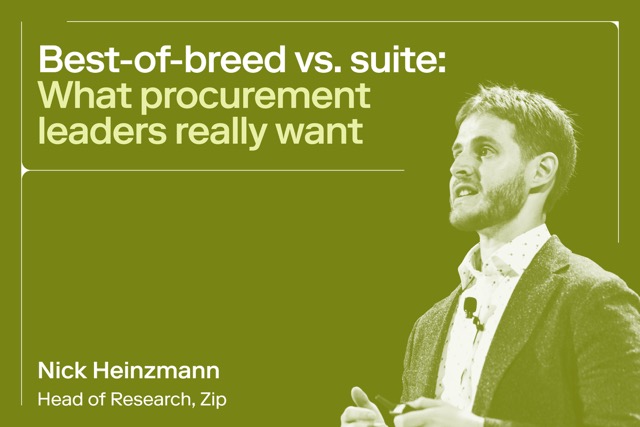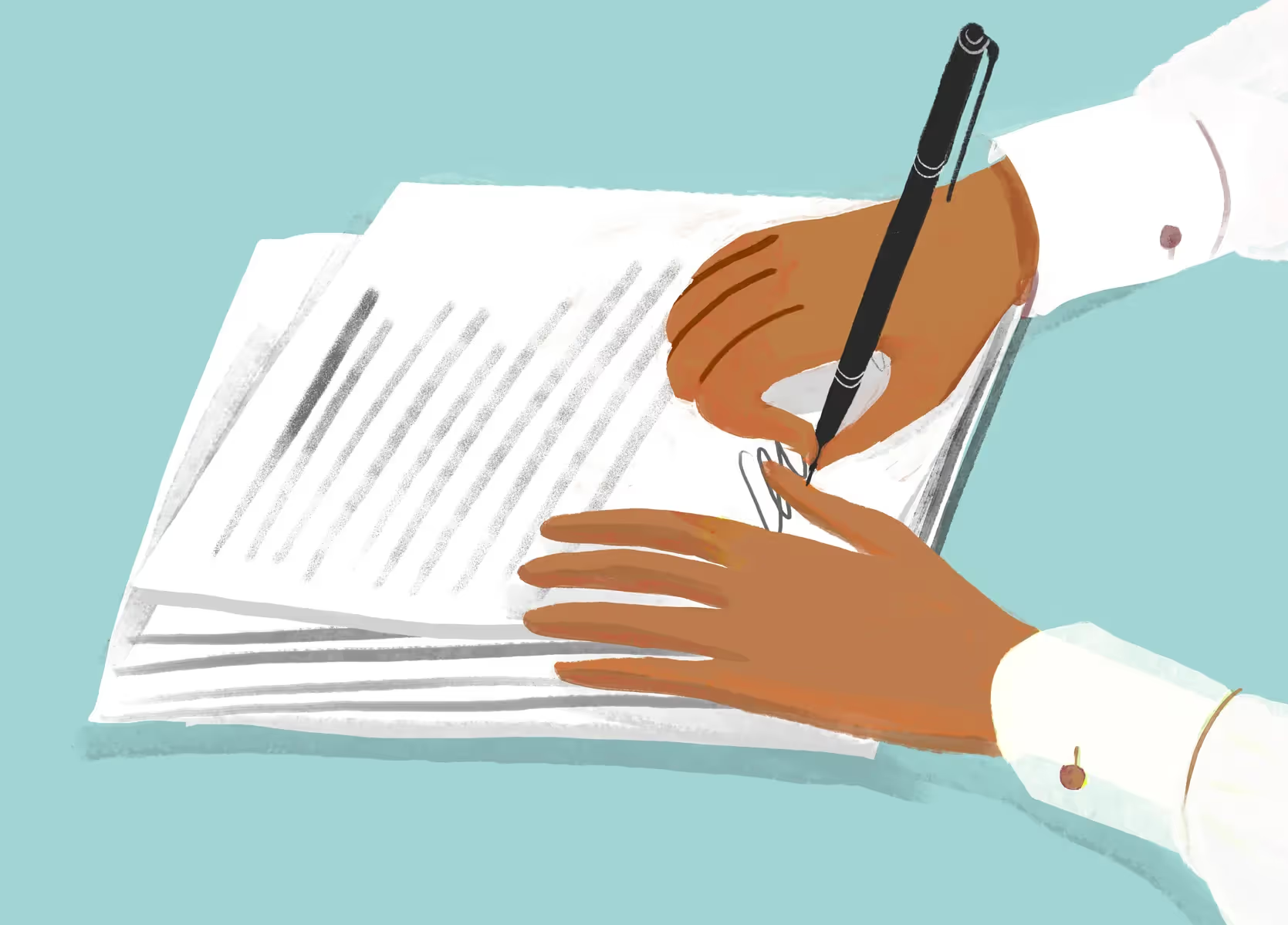
Procure-to-Pay automation: A guide to smooth spending
Learn how Zip automation can streamline AP and boost your procurement team.

Is your team drowning in the sea of paperwork that comes with managing your company's purchases? Without the right tools, the procure-to-pay (P2P) process can be a real challenge, filled with manual labor and prone to error. But what if there was a way to streamline it all, saving you time and money? That's where procure-to-pay automation comes in.
Imagine a world where you can process purchase requisitions in a flash, verify invoices automatically, and make payments with a click of a button. With P2P automation, this dream is becoming a reality. In this article, we'll explore how this game-changing technology can transform your procurement process, boosting efficiency and making your life easier.
What is procure-to-pay automation?
Procure-to-pay automation uses technology to streamline and optimize the steps in the procure-to-pay process. It empowers businesses to replace hands-on tasks with automated systems, connect different systems to share information seamlessly, and get real-time data to make better decisions.
A recent survey found that many companies are already automating their buying processes. In fact, 98% of decision-makers are planning to invest more in procurement automation tools like AI and advanced analytics within the next few years.
The purpose of P2P automation is to enhance efficiency, reduce costs, and elevate the strategic value of the procurement function. But what does this mean in practical terms? Let’s take a deeper look.
6 ways to use procure-to-pay automation

Procure-to-pay automation is revolutionizing how businesses manage their procurement and accounts payable (AP) processes. From automating purchase requests to streamlining invoice processing and payment, let’s look at some of the ways you can implement P2P automation to benefit your business.
1. Requisition creation and approval
Requisition creation and approval is the initial step in the procurement process where a company authorizes a request for goods or services. Traditionally, this process requires procurement teams to manually fill out forms, obtain approvals from stakeholders, and route documents for further processing. This can be time-consuming and error-prone.
AP automation can streamline purchase requisition creation and approval by digitizing the entire process. Here's how it works:
- Submit requisitions electronically: Send requisitions through a user-friendly interface, often integrated with your existing ERP system. The system can pre-populate fields with relevant information, reducing manual data entry.
- Automate workflow: Requisitions are automatically routed to designated approvers based on predefined rules and hierarchies. Approvers can review and approve or reject requests online, eliminating the need for physical paperwork and manual routing.
- Track requisitions in real time: Automated systems provide visibility into the status of requisitions, allowing you to monitor progress and identify any bottlenecks. Notifications can be sent to relevant parties when approvals are required or when a requisition reaches a specific stage in the process.
- Maintain a centralized repository: All requisition-related documents are stored electronically in a centralized repository, making it easy to access and audit information.
2. Purchase order generation and management
Purchase order (PO) generation and management is the process of creating and managing formal documents that authorize vendors to provide goods or services. P2P automation can simplify purchase order management by automating many of the manual tasks involved:
- Create purchase orders automatically: Generate POs based on approved requisitions, eliminating the need for manual data entry.
- Deliver purchase orders electronically: Automatically send purchase orders directly to vendors to speed up the procurement process.
- Integrate shipment tracking: P2P software can integrate with shipping carriers to automatically track shipments and update the purchase order status.
- Automate invoice matching: Match invoices to purchase orders based on PO number, vendor, and item details, reducing manual reconciliation efforts.
- Process payments automatically: For approved invoices, automated P2P systems can automatically generate payment files and initiate payments, reducing manual data entry and processing time.
- Track vendor performance: The system can track vendor performance metrics, such as delivery times, quality, and pricing, to help you make informed decisions about your supplier base.
3. Invoice processing and management
Invoice processing is a cornerstone of efficient procurement, but hands-on methods can be tedious. New automation features like AI invoice processing, invoice receipt, matching, verification, and payment can significantly streamline this process. For example, these systems can:
- Capture invoices automatically: Capture invoices from various sources, such as email, EDI, or paper scans using automation.
- Match invoices to purchase orders: Automated software can automatically match invoices to purchase orders based on PO number, vendor, and item details.
- Verify invoice accuracy: Verify invoice accuracy by checking for errors, inconsistencies, or discrepancies.
- Route invoices automatically: Automatically route approved invoices to designated approvers based on predefined rules and hierarchies.
4. Payment processing
Payment processing is the final step in the P2P process where payments are made to vendors for goods or services received. Before automation, this would involve manually creating payment files, initiating payments, and reconciling bank statements. P2P automation can help:
- Generate payment files: Generate payment files in the desired format, such as ACH or wire transfer, based on approved invoices and payment terms.
- Initiate payments: Initiate payments to vendors based on the approved payment files.
- Reconcile bank statements: Automatically reconcile bank statements to purchase orders and invoices, ensuring accuracy and identifying any discrepancies.
- Manage vendor relationships: Track vendor payments and performance data to manage your supplier relationships more effectively.
5. Vendor selection and negotiation
Finding the right vendors to do business with can be a daunting task, especially when sifting through hundreds of potential partners. From research to negotiating final contracts, it can take weeks or even months before you’re actually receiving the goods and services you need.
With P2P automation, you can save time and resources on vendor selection by automating most of the process. For example, P2P automation can:
- Create vendor profiles: The system can create and manage vendor profiles, storing information about their products, services, pricing, and performance.
- Send requests for proposals (RFPs): Once you’ve found a vendor you’re interested in, you can send RFPs electronically and eliminate the need for manual distribution and tracking.
- Compare bids: Automatically compare bids from different vendors based on predefined criteria, such as price, quality, and delivery terms.
- Manage contracts: Store and manage vendor contracts within your P2P software to ensure all terms and conditions are met.
- Track vendor performance: P2P automated systems can track vendor performance data, such as delivery times, quality, and pricing, to help you make informed decisions about your supplier base.
6. Contract management
Procurement contracts define the terms and conditions of your business relationships, ensuring both parties understand their rights and obligations. These terms and conditions can make or break a vendor relationship.
Contract management plays a major role in the procurement process, but paperwork and deadlines can get lost in the fray when working with hundreds of vendors. P2P automation can help take some of the work off your plate:
- Store and manage contracts: P2P solutions can store contracts electronically, making them easily accessible and searchable.
- Set reminders for key dates: The system can send reminders for upcoming contract renewals, expiration dates, or performance reviews.
- Track contract compliance: P2P software can help you monitor vendor performance against contract terms and identify any non-compliance issues.
- Manage contract amendments: Automated systems can track and manage contract amendments, keeping all parties aware of any changes.
- Collaborate with vendors: P2P automation can facilitate collaboration with vendors by providing a central platform for communication and document sharing.
Benefits of P2P automation

The procure-to-pay process is a normal, healthy, and important operation at any business at any scale, but it can come with challenges that can hinder efficiency and increase costs. Siloed data, process bottlenecks, human errors, and complex processes are just a few ways outdated P2P practices may be slowing you down.
P2P automation can help address common challenges businesses face. Let’s dive into some of the specific benefits of automating your procurement process.
Improved efficiency and productivity
P2P automation streamlines processes by eliminating repetitive manual tasks and reducing processing time, allowing you to process transactions faster and more efficiently. This frees up employees to focus on more strategic tasks, improving overall productivity.
Reduced manual errors and increased accuracy
Automation reduces the risk of human error by automating data entry and validation processes, improving data accuracy and reliability. Automated workflows and checks also help ensure transactions are processed correctly, lifting some of the load off your procurement team.
Enhanced financial visibility and control
With all data in one place, automation provides better visibility into the P2P process. This allows for real-time tracking of purchases, routing and supply chain management, automating vendor payments, and supplier management, enabling more informed decision-making.
Strengthened vendor relationships
With timely payments and better communication, automation can help improve vendor relationships. This can lead to better terms, improved service, and a more reliable supply chain.
Increased compliance with regulations
Automation can enforce procurement policies, ensuring compliance with internal and external regulations. This not only reduces the risk of fines and penalties but also helps maintain the organization’s reputation.
Standardized processes across the organization
P2P automation establishes consistent workflows and rules for tasks like requisition creation, purchase order generation, and invoice processing. This ensures everyone follows the same procedures, reducing errors and improving efficiency.
How to choose the right procure-to-pay tool
Choosing the right procure-to-pay software that can assist procurement teams throughout every stage of the approval process can be difficult. These days, there are incredible software solutions that can empower procurement teams, increase audit trails, and integrate with your ERP system and other best-of-breed tools your organization already uses.
Here’s how to select the right P2P software for your business needs:
Identify your needs for procurement
Modern e-procurement and spend management tools will often feature detailed spend analytics, real-time insights, automated notifications and reminders, and centralized workflows powered by AI. Figure out what your teams need to thrive in order to help select the right software.
Look for integration capabilities
Integration capabilities are essential when choosing a P2P automation software. By seamlessly integrating with your existing systems like your ERP software, you can support the flow of data between different systems. This unified view of your procurement and accounts payable processes can help you break down data silos, identify bottlenecks, and optimize operations.
Consider scalability and flexibility to accommodate future growth
As your business grows and evolves, your procurement and accounts payable needs may change. A scalable solution can accommodate increasing transaction volumes and adapt to new requirements without significant disruption. Look for software that can be customized to fit your specific processes and workflows, allowing you to tailor it to your unique needs.
By choosing a scalable and flexible P2P automation solution, you can future-proof your operations and avoid the need for frequent software upgrades or replacements.
Measure cost and return on investment
Sure, P2P automation software might cost a bit upfront, but the long-term rewards are huge. By figuring out how much you can save on manual work, faster processes, and fewer mistakes, you can see if the software is worth it.
Consider factors like cost per transaction, implementation time, and ongoing maintenance costs to determine if the investment is worth the cost. Or, just use our handy ROI calculator to find out how much you could be saving on your operations with Zip.
Compare competitors and select the best fit
Once you’ve whittled down your options, take the time to thoroughly compare each before making your decision. Consider factors such as cost, features, customer support, user reviews, and the vendor's reputation. By comparing competitors, you can make an informed decision and choose the P2P automation software that offers the best value and meets your business’s long-term goals.
Accelerate your workflow with Zip procure-to-pay automation
It's clear that procure-to-pay automation is now a must-have for streamlining procurement, tackling tough challenges, and saving time and money. Finding the right P2P software is key to staying ahead of the game and making sure your company is ready for whatever comes next.
Ready to transform your procurement process? Zip offers a comprehensive procure-to-pay automation solution tailored to meet the needs of procurement and financial leaders. Request a demo of Zip's procurement orchestration platform today and discover how to accelerate your procurement workflows.

Maximize the ROI of your business spend

Enter your business email to keep reading



























.webp)




















.avif)













.avif)









.webp)





.avif)












.avif)
